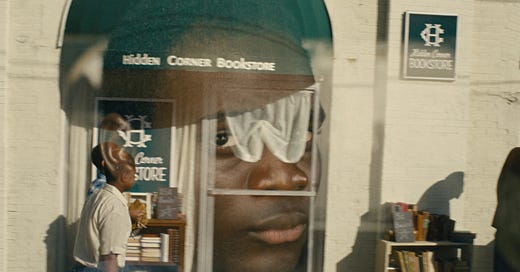The camera cannot distinguish between bearing witness and gawking, because the instrument is at the whims of its audience. The images it creates are unconscious to whether they are tokens of reality or partners in the creation of a myth. How can we know if the images we capture will be folded into the status quo or recontextualize the very ground we walk on? Nickel Boys director RaMell Ross evaluates this dilemma of bearing witness by recognizing it as incomparable to being witnessed — in his words, “a psychological double-consciousness, where you’re both in it and on the outside of it.” Our ability to see is eclipsed by how we’ve been made to be seen by the world.
Nickel Boys begins with a montage of simple sensory experiences from first-person perspective. A set of fresh sheets billowing over your head before coming to rest. The gentle tug-of-war between your hand and a balloon before you let the helium pull it upwards and bounce off the blades of a ceiling fan. Ross begins with simple tableaus of feeling before these textures are grounded into any narrative — long before we know whose body we are in, we know the feelings of this body intimately.
While Nickel Boys rigidly remains within a first-person view, we come to know who it belongs to well: Elwood Curtis (Ethan Herisse). At first we only see him when he catches a glimpse of himself — warped in the shiny surface of his Nana’s (Aunjanue Ellis-Taylor) iron as it glides by, or frozen still in the reflection of a shop window as a dozen TVs go static on the other side of the glass. Then we come to know Elwood through what he sees, which is a world of potential. Men are setting foot on the moon and Dr. King’s words are echoing from a news broadcast. Elwood’s teacher sees the same potential in him, encouraging him to enroll in college classes and get involved in local civil rights activism.
But Elwood’s optimism in what he sees cannot be divorced from how he’s seen as a Black man in 1960s Tallahassee, from the stick-figure flipbook of a lynching sketched into his history book to being passed by a truck with wooden cross tied to its flatbed which leaves a trail of sparks as it drags along the road. He also sees the torso of a cop standing next to the stolen car that he happens to be hitchhiking in, though the driver has told him to look away.
After his subsequent arrest, Elwood is sent to Nickel Academy, an abusive reform school where he meets Turner (Brandon Wilson), who’s been there for some time. Where Elwood is optimistic, Turner is disillusioned. Where Elwood wants to change Nickel, Turner knows there’s only a few ways out, and one of them is to be buried in an unmarked grave at the back of the estate’s property. Where Elwood lives hoping to be remembered, Turner has accepted the oblivion of the fact that he definitely won’t be.
As we get to know Turner, we are eventually granted his point-of-view as well. We see the friendship between the two boys slowly materialize, their shared reality tugging their opposing attitudes together into an intricate waltz of resilience that alternates between eyes always looking upward and eyes trained to the ground they walk on. We no longer have to imagine the body we live in by how it’s seen by others — without ever giving up the POV conceit, Nickel Boys allows us to understand Elwood and Turner through each other.
But slowly, we realize that the two boys are no longer seen by others at all. They’ve been banished to an isolated facility by a carceral state that sees potential in their expendable bodies but no purpose in their being. Boys from Nickel vanish all the time without being seen by the outside world; Elwood and Turner’s gaze is the only account of each other’s existence. The simple visual poetry of Nickel Boys is a radical act of both seeing and being seen — the subjective lyricism of singular lives clashing with the weight of their images as analogs for all those who have been erased by the unimaginable cruelty embedded within our state. “There are Nickels all over this country,” says Turner. The monumental weight of each of their lives has been folded into a tragic, sparsely remembered archive, re-evaluated by periodically jumping forward in time to a man who always keeps his back to the camera — a man who goes unidentified until the past and the present come careening into one.
Nickel Boys has countless moments of profound revelation, but they are derived entirely from its radical aesthetic approach. While interspersed with sobering archival montages, the film articulates its poetic, emancipatory perspective through single moments lived in real time. The instruction of the frame is not just a world seen and felt, but a body within the world. A document sits on a blank plain of paper-white while a body sees life slip past it in bands of brilliant color. Power is predicated on the ability to control what is seen and what is remembered — Nickel Boys places us into the bodies of those forced to be forgotten, galvanizing us with the simple invitation to pick an orange from a tree or gently turn a coin between our fingers.
OVERALL SCORE: 10/10
Nickel Boys was released on December 13 and is currently showing in US theaters.





no comment.